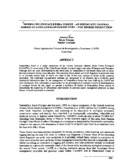Modelling Pentaclethra forest - an important Central American lowland rain forest type - for timber production
Alternative title
Modelling Pentaclethra forest - an important Central American lowland rain forest type - for timber production : Long-term observations and research in forestry; proceedings
Abstract
Pentaclethra forest is a major component of the Central American Atlantic Moist Forest Ecoregion (CAAMFE). It covers most of the Costa Rican Atlantic Lowland region and parts of Panama and Nicaragua. Although soils are poor, deforestation in this forest type, for pastureland or permanent crops such as citrus, has been extensive during recent decades. The remaining forest stands, are small fragments in protected areas or on privately owned land, of which, the latter is one of the main sources of timber in the countries mentioned. The traditional long-and-leave methods are recognized to be obsolete and a relatively good biophysical information base for the management of Pentaclethra forests has been built up by CATIE and other institutions. This information is appropriate for the development of computer models of stand dynamics in managed forests. In this paper we present a synthesis of studies in Pentaclethra forest aiming to demonstrate the feasibility of silvicultural interventions to promote sound management practices in these forests. A model framework is presented.
Keywords
Publisher
CATIE
Is part of
IUFRO S4.11 International Symposium;
URI (Permanet link to cite or share this item)
https://repositorio.catie.ac.cr/handle/11554/7043Collections
- Publicaciones y documentos [4167]


